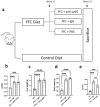Dual role of neutrophils in modulating liver injury and fibrosis during development and resolution of diet-induced murine steatohepatitis
- PMID: 34921208
- PMCID: PMC8683497
- DOI: 10.1038/s41598-021-03679-w
Dual role of neutrophils in modulating liver injury and fibrosis during development and resolution of diet-induced murine steatohepatitis
Abstract
Inflammatory changes in the liver represent a key feature of non-alcoholic steatohepatitis (NASH), the progressive form of non-alcoholic fatty liver disease (NAFLD). Innate immune activation including hepatic neutrophilic infiltration acts as an important inflammatory trigger as well as a potential mediator of inflammation resolution. In this study, we dissected the effects of neutrophil depletion via anti-lymphocyte antigen 6 complex locus G6D (Ly6G) antibodies administration during ongoing high fat-fructose-cholesterol (FFC) diet-induced murine NASH and during inflammation resolution by switching into a low-fat control diet. During NASH progression, protective effects were shown as HSC activation, cell infiltration and activation of pro-inflammatory macrophages were ameliorated. Furthermore, these changes were contrasted with the effects observed when neutrophil depletion was performed during the resolution phase. Impaired resolving mechanisms, such as a failure to balance the pro and anti-inflammatory cytokines ratio, deficient macrophage phenotypic switch into a pro-restorative profile, and defective repair and remodeling processes were observed when neutrophils were depleted in this scenario. This study described phase-dependent contrasting roles of neutrophils as triggers and pro-resolutive mediators of liver injury and fibrosis associated with diet-induced NASH in mice. These findings have important translational implications at the time of designing NASH therapeutic strategies.
© 2021. The Author(s).
Conflict of interest statement
The authors declare no competing interests.
Figures







Similar articles
-
Lipocalin-2 mediates non-alcoholic steatohepatitis by promoting neutrophil-macrophage crosstalk via the induction of CXCR2.J Hepatol. 2016 Nov;65(5):988-997. doi: 10.1016/j.jhep.2016.05.041. Epub 2016 Jun 4. J Hepatol. 2016. PMID: 27266617
-
Myeloid-specific deletion of chitinase-3-like 1 protein ameliorates murine diet-induced steatohepatitis progression.J Mol Med (Berl). 2023 Jul;101(7):813-828. doi: 10.1007/s00109-023-02325-4. Epub 2023 May 11. J Mol Med (Berl). 2023. PMID: 37166517 Free PMC article.
-
TLR9 is up-regulated in human and murine NASH: pivotal role in inflammatory recruitment and cell survival.Clin Sci (Lond). 2017 Jul 24;131(16):2145-2159. doi: 10.1042/CS20160838. Print 2017 Aug 15. Clin Sci (Lond). 2017. PMID: 28687713
-
Progression of non-alcoholic steatosis to steatohepatitis and fibrosis parallels cumulative accumulation of danger signals that promote inflammation and liver tumors in a high fat-cholesterol-sugar diet model in mice.J Transl Med. 2015 Jun 16;13:193. doi: 10.1186/s12967-015-0552-7. J Transl Med. 2015. PMID: 26077675 Free PMC article.
-
Galectin-3 and IL-33/ST2 axis roles and interplay in diet-induced steatohepatitis.World J Gastroenterol. 2016 Nov 28;22(44):9706-9717. doi: 10.3748/wjg.v22.i44.9706. World J Gastroenterol. 2016. PMID: 27956794 Free PMC article. Review.
Cited by
-
Inflammation in MASLD progression and cancer.JHEP Rep. 2025 Apr 2;7(8):101414. doi: 10.1016/j.jhepr.2025.101414. eCollection 2025 Aug. JHEP Rep. 2025. PMID: 40671831 Free PMC article. Review.
-
Advancements in MAFLD Modeling with Human Cell and Organoid Models.Int J Mol Sci. 2022 Oct 6;23(19):11850. doi: 10.3390/ijms231911850. Int J Mol Sci. 2022. PMID: 36233151 Free PMC article. Review.
-
NKG2D-mediated detection of metabolically stressed hepatocytes by innate-like T cells is essential for initiation of NASH and fibrosis.Sci Immunol. 2023 Sep 29;8(87):eadd1599. doi: 10.1126/sciimmunol.add1599. Epub 2023 Sep 29. Sci Immunol. 2023. PMID: 37774007 Free PMC article.
-
C-C motif chemokine receptor 2 inhibition reduces liver fibrosis by restoring the immune cell landscape.Int J Biol Sci. 2023 May 8;19(8):2572-2587. doi: 10.7150/ijbs.83530. eCollection 2023. Int J Biol Sci. 2023. PMID: 37215993 Free PMC article.
-
Beyond host defense and tissue injury: the emerging role of neutrophils in tissue repair.Am J Physiol Cell Physiol. 2024 Mar 1;326(3):C661-C683. doi: 10.1152/ajpcell.00652.2023. Epub 2024 Jan 8. Am J Physiol Cell Physiol. 2024. PMID: 38189129 Free PMC article. Review.

